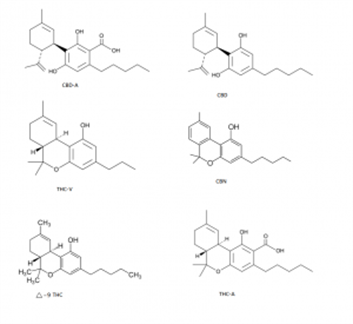Psychoactive Compounds Analysis in Cannabinoids - AppNote
January 22, 2020
/
/
/
/
Cannabinoid Separation Method
Due to the number of expanding products of homeopathic extracts from Hemp, there is an equally increasing necessity to accurately analyze and separate the numerous compounds from these natural samples. While Cannabidiol has been extracted for multiple natural remedies, there is also numerous unwanted psychoactive constituents and related compounds that may also reside in these over the counter (OTC) supplements.
The presented data illustrates how these standards can be both optimally separated and provide good run-to-run Precision using this Method.

Column: Cogent Bidentate C18™, 4μm, 100Å
Catalog No.: 40018-15P
Dimensions: 4.6 x 150mm
Mobile Phase: 75:25 Acetonitrile / DI Water with 0.1% Formic Acid
Injection vol.: 1μL
Flow rate: 1.0 mL/minute
Detection: UV @ 220nm
Sample: Cannabinoid mixture 0.1 mg / mL (100ppm) of each
Notes: These compounds are found in the flower of plants in the genus Cannabis. CBD is one of over one hundred identified cannabinoids in cannabis plants and can account for 40% of the plant’s extract. CBD may carry properties to reduce anxiety and provide anti-psychotic effects by having a low affinity for the cannabinoid CB1 and CB2 receptors. Multiple strains of Cannabis have been found to contain a significant variation in ratios of CBD to THC, the main psychoactive compound found in marijuana. As defined by U.S. federal law, non- psychoactive hemp (also commonly termed as industrial hemp), cannot contain a ∆-9 tetrahydrocannabinol concentration of more than 0.3% on a dry-weight basis.

Attachment
Cannabinoid Separations pdf 0.3 Mb Download File
Due to the number of expanding products of homeopathic extracts from Hemp, there is an equally increasing necessity to accurately analyze and separate the numerous compounds from these natural samples. While Cannabidiol has been extracted for multiple natural remedies, there is also numerous unwanted psychoactive constituents and related compounds that may also reside in these over the counter (OTC) supplements.
The presented data illustrates how these standards can be both optimally separated and provide good run-to-run Precision using this Method.


Peaks:
1. Cannabidiolic Acid
2. Cannabindiol
3. Tetrahydrocannabivarin
4. Cannabinol
5. Tetrahydrocannabinol
6. Tetrahydrocannabinolic Acid A
Column: Cogent Bidentate C18™, 4μm, 100Å
Catalog No.: 40018-15P
Dimensions: 4.6 x 150mm
Mobile Phase: 75:25 Acetonitrile / DI Water with 0.1% Formic Acid
Injection vol.: 1μL
Flow rate: 1.0 mL/minute
Detection: UV @ 220nm
Sample: Cannabinoid mixture 0.1 mg / mL (100ppm) of each
Notes: These compounds are found in the flower of plants in the genus Cannabis. CBD is one of over one hundred identified cannabinoids in cannabis plants and can account for 40% of the plant’s extract. CBD may carry properties to reduce anxiety and provide anti-psychotic effects by having a low affinity for the cannabinoid CB1 and CB2 receptors. Multiple strains of Cannabis have been found to contain a significant variation in ratios of CBD to THC, the main psychoactive compound found in marijuana. As defined by U.S. federal law, non- psychoactive hemp (also commonly termed as industrial hemp), cannot contain a ∆-9 tetrahydrocannabinol concentration of more than 0.3% on a dry-weight basis.

Attachment
Cannabinoid Separations pdf 0.3 Mb Download File
